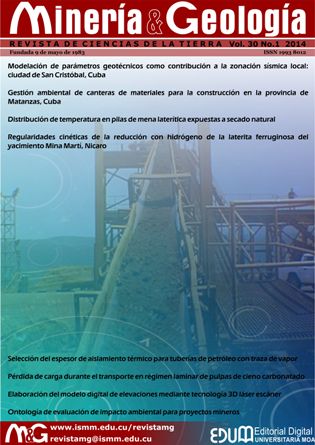Environmental impact assessment ontology for mining projects
Keywords:
ontology, environmental impact assessment, mining, intelligent systemsAbstract
Ontology is a tool that allows understanding between the parties that share a common knowledge. The presented ontology comprises fundamental concepts of environmental impact assessments performed for mining projects. This ontology was designed based on the methodology recommended by the University of Standford and Protégé editor. The Mining EIA ontology constitutes an initial step in formalizing knowledge about environmental impact assessments in the mining industry and in creating intelligent systems in this area.Downloads
References
CUBA. 1997: Ley 81 del Medio Ambiente. Gaceta Oficial de la República de Cuba. Edición extraordinaria, La Habana, 11 de julio, año XCV, No. 7, p. 47.
CONESA-FERNÁNDEZ, V. 1997: Guía Metodológica para la Evaluación de Impacto Ambiental. 3ra edición. Mundi-Prensa, Madrid.
DIVISIÓN DE INFORMÁTICA MÉDICA DE LA UNIVERSIDAD DE STANFORD (DIMUS). 2013: Protégé. Disponible en: http://protege.stanford.edu.
MUÑOZ, E.; CAPÓN-GARCÍA, E.; LAÍNEZ, J. M.; ESPUÑA, A. & PUIGJANER, L. 2013: Considering environmental assessment in an ontological framework for enterprise sustainability. Journal of Cleaner Production 47(May): 149-164. ISSN 0959-6526. Disponible en: http://dx.doi.org/10.1016/j.jclepro.2012.11.032.
FERNÁNDEZ, M.; GÓMEZ-PÉREZ, A. & PAZOS, J. 1999: Building a chemical ontology using methontology and the ontology design environment. IEEE Intelligent Systems. January/February.
FERNÁNDEZ-LÓPEZ, M. 1999: Overview of methodology for building ontologies. Laboratorio de Inteligencia Artificial. Universidad politécnica de Madrid. Madrid. España. Disponible en: http://www.lsi.upc.es/~bejar/aia/aia-web/4-fernandez.pdf
GARRIDO SÁNCHEZ, J. 2011: Ontologías para la evaluación de Impacto Ambiental de las actividades humanas. Tesis doctoral. Departamento de Ciencias de la Computación e Inteligencia Artificial. Universidad de Granada, E.T.S de Ingeniería Informática y de Telecomunicación. 252 p.
GRUBER, T. 1993: A traslation approach to portable ontology specification. Knowledge Acquisition 5.
NOY, N. & MCGUINNESS, D. 2001: Ontology development 101: A Guide to creating your first ontology. Stanford University. Stanford knowledge Systems Laboratory Technical Report.
SÁNCHEZ MUÑOZ, D. 2008: Modelo Jerárquico de Evaluación de Impacto Ambiental empleando Técnicas Difusas. Tesis doctoral. Departamento de Ciencias de la Computación e Inteligencia Artificial. Universidad de Granada, E.T.S de Ingeniería Informática. 236 p
USCHOLD, M. & GRUNINGER, M. 1996: Ontologies: Principles, Methods and Applications. AIAI-TR-191. Disponible en: http://citeseer.nj.nec.com/uschold96ontologie.html
USCHOLD, M. 1996: Ontologies: Towards a unified methodology. AIAI-TR-197. Disponible en http://citeseer.nj.nec.com/uschold96building.html
UNSPSC. 2013: Disponible en: http://www.unspsc.org.
WANG, N. & XU, X. 2000: A method to build ontology. En: High Performance Computing in the Asia-Pacific Region 2000 Proceedings, The Fourth International Conference. May, vol. 2, p. 672–673.
Published
How to Cite
Issue
Section
- Authors retain copyright and guaranteeing the right magazine to be the first publication of the work as licensed under a Creative Commons Attribution-NonCommercial that allows others to share the work with an acknowledgment of the work's authorship and initial publication in this journal.
- Authors may establish separate supplemental agreements for the exclusive distribution version of the work published in the journal (eg, place it in an institutional repository or publish it in a book), with an acknowledgment of its initial publication in this journal.
- Authors are allowed and recommended to disseminate their work through the Internet (e.g., in institutional telematic archives or on their websites) before and during the submission process, which can produce interesting exchanges and increase citations of the published work. (See The effect of open access)










